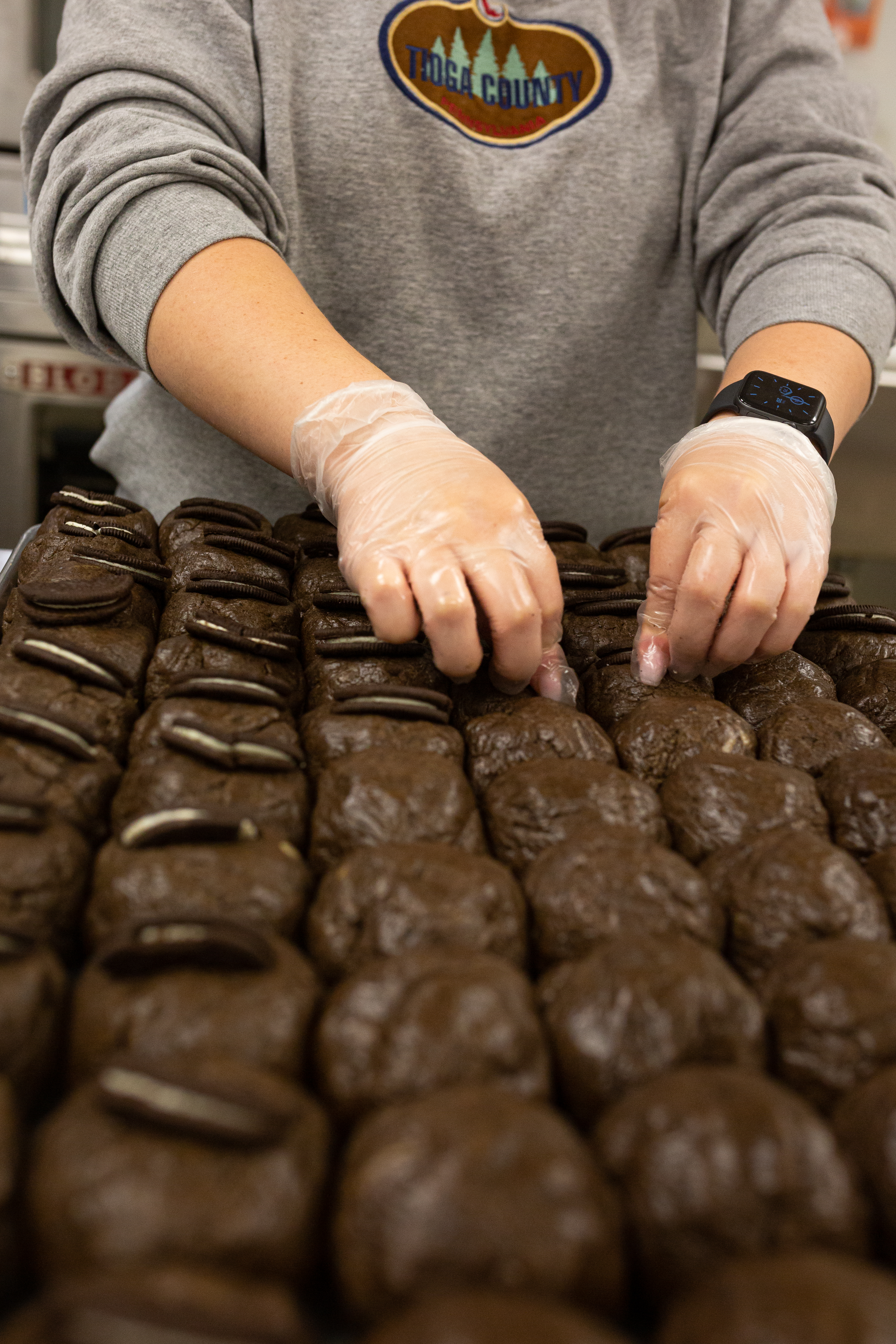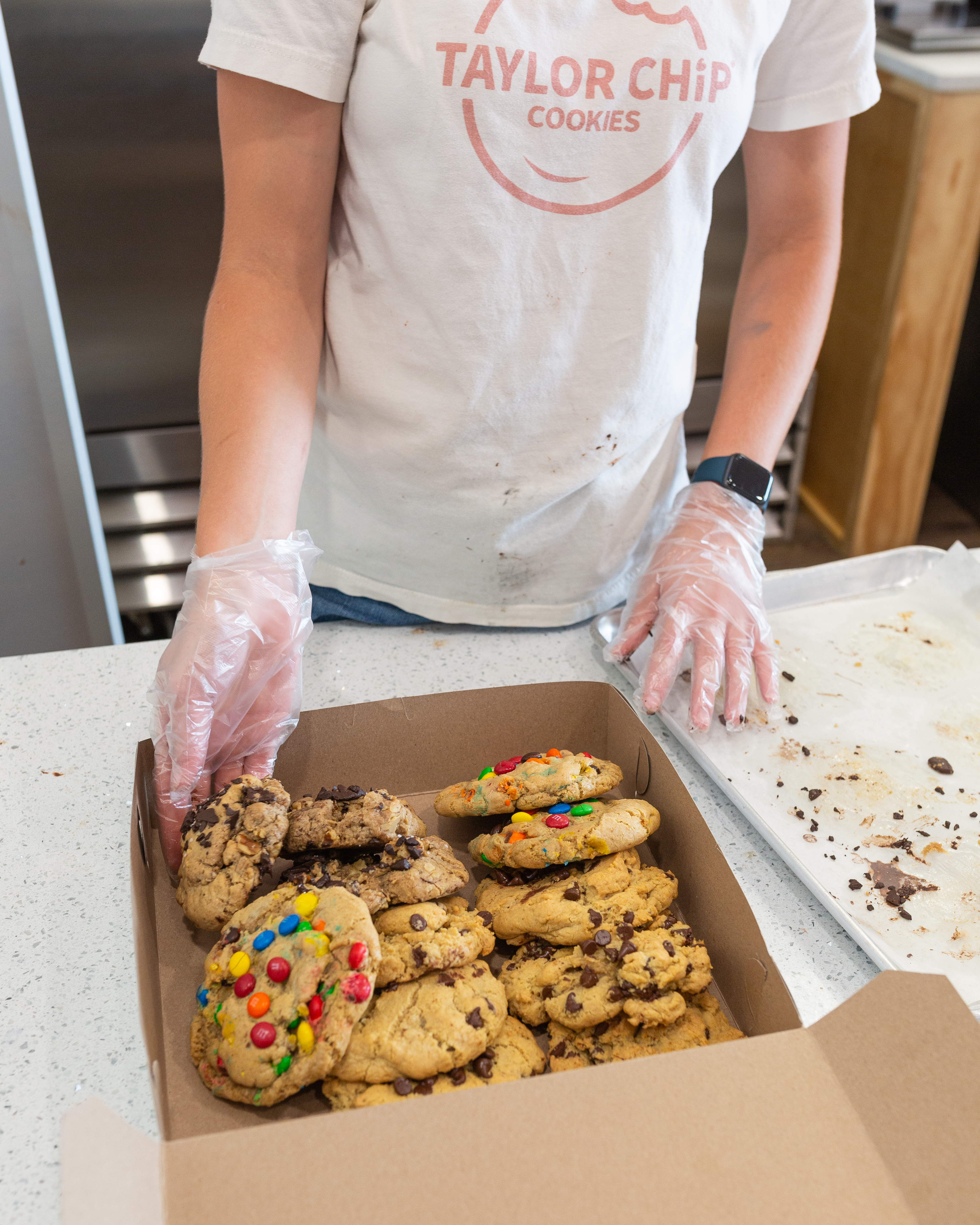If your dog ate a chocolate chip cookie, act quickly by evaluating their condition and identifying symptoms like vomiting or restlessness. Contact your veterinarian immediately, providing details about the type and amount of chocolate consumed. Chocolate contains theobromine, toxic for dogs, and even small amounts can lead to severe issues. Your vet may suggest inducing vomiting or administering activated charcoal to reduce theobromine absorption. Prevent future incidents by storing chocolate in high, secure places, and educating everyone in your household about the dangers. Proper prevention, awareness, and swift action are key to safeguarding your pet's health and learning more about effective measures helps.
Key Takeaways
- Look for symptoms like vomiting, diarrhea, restlessness, and contact a veterinarian immediately if your dog eats a chocolate chip cookie.
- Identify the type and quantity of chocolate ingested to assess toxicity risk.
- Induce vomiting and administer activated charcoal only under veterinary guidance.
- Store chocolate products securely out of your dog's reach to prevent accidental ingestion.
- Educate family and guests about the dangers of feeding dogs chocolate and other toxic foods.
Understanding Chocolate Toxicity in Dogs
When your dog eats chocolate, it's essential to understand the different types and their theobromine levels, as this substance is toxic to dogs. Dark chocolate and baking chocolate contain higher levels of theobromine compared to milk chocolate, making them more dangerous. Knowing these differences can help you assess the severity of the situation and take appropriate action quickly.
Types of Chocolate and Their Theobromine Levels
To better understand chocolate toxicity in dogs, it's crucial to know the types of chocolate and their varying theobromine levels. Theobromine is the compound that makes chocolate toxic to dogs, and different types of chocolate contain different amounts of it. Dark chocolates, for instance, have the highest theobromine levels due to their high cocoa content, making them particularly dangerous. Semi-sweet chocolate also poses a noteworthy risk, though it contains slightly less theobromine than dark chocolate.
In contrast, white chocolate has negligible theobromine levels because it lacks cocoa solids, but it's still not advisable for dogs due to its high fat and sugar content. The toxic dose of theobromine depends on your dog's weight and the type of chocolate ingested. For instance, a small dog may suffer chocolate toxicity from ingesting just a small amount of dark chocolate, whereas a larger dog might tolerate more.
If your dog experiences chocolate ingestion, monitor them closely and contact an emergency vet immediately, especially if they've consumed dark or semi-sweet chocolate. Understanding the cocoa content and theobromine levels in different chocolates can help you quickly assess the severity of the situation.

Choose Your Own Delightfully Perfect Cookies.
With almost 30 flavors to choose from, you can make your box as unique as you are.
Immediate Actions to Take
First, assess your dog's condition for any immediate symptoms like vomiting, diarrhea, or restlessness, as these can indicate chocolate poisoning. If your dog shows any of these signs, contact your veterinarian right away for guidance. Even if symptoms are not yet present, it's essential to call your vet and describe the situation to determine if further action is needed.
Assessing the Situation and When to Seek Help
Evaluating the situation quickly is crucial after your dog has eaten a chocolate chip cookie. First, identify the type of chocolate in the cookie, as different chocolates contain varying amounts of theobromine, the toxic substance to dogs. Dark and baking chocolates have higher concentrations and pose greater risks than milk chocolate.
Next, assess your dog's size and the quantity consumed. Larger dogs can tolerate more theobromine, while smaller dogs are at higher risk. Monitor your dog for signs of poisoning such as stomach upset, vomiting, diarrhea, increased heart rate, or body tremors. These symptoms indicate toxic effects and require immediate attention.
If any signs of poisoning appear, an emergency vet visit is essential. Describe the type of chocolate and the estimated amount ingested to the vet, as this information helps determine the severity of the situation and the necessary emergency treatment. In some cases, inducing vomiting or administering activated charcoal may be recommended to reduce absorption.
Even if symptoms aren't immediately evident, contacting your vet for advice is always wise. Prompt action can prevent serious health issues, ensuring your dog receives the appropriate care quickly and efficiently.
Symptoms and Timeline of Chocolate Poisoning
When your dog consumes chocolate, the onset of poisoning symptoms can vary based on the type and amount of chocolate ingested. Chocolate chip cookies contain theobromine, which is toxic to dogs. The clinical signs of poisoning can appear within 6 to 12 hours post-ingestion. You might notice increased heart rate, rapid breathing, raised body temperature, and higher blood pressure. These symptoms are due to theobromine and caffeine, both found in high concentrations of cocoa.
Initially, your dog may exhibit restlessness, vomiting, or diarrhea. As the condition worsens, more severe symptoms like muscle tremors, seizures, and irregular heartbeats can occur. Rapid breathing and an increased heart rate are critical signs requiring immediate attention. Heightened body temperature is another red flag. If you observe any of these clinical signs, seek emergency veterinary care right away.
Knowing the timeline helps you act quickly. After ingestion, initial symptoms might be mild but can escalate rapidly. Monitor your dog's behavior closely. If your dog has ingested chocolate chip cookies, especially those with high concentrations of cocoa, don't wait—contact your veterinarian immediately to prevent severe complications.
Treatment Options
When your dog has consumed a chocolate chip cookie, immediate action is vital, and understanding your treatment options is important. You can choose between seeking veterinary treatments, which can include inducing vomiting and administering activated charcoal, or home care methods if professional help isn't immediately available. This section will guide you through the steps for both approaches to guarantee your dog's safety.
Veterinary Treatments and Home Care
If your dog has eaten a chocolate chip cookie, prompt treatment is vital to prevent serious health issues. The first step is to assess the severity using a chocolate toxicity calculator. This helps determine the potential effects of theobromine, the toxic component in chocolate. High concentrations of theobromine can lead to rapid heart rate, seizures, and even death.
Contact your veterinarian or an animal hospital immediately. They will advise you based on common chocolate poisoning symptoms, including mild stomach upset to advanced signs like tremors and irregular heartbeat. Dangerous foods like chocolate require urgent attention, so don't delay seeking help.
Your vet might induce vomiting to expel the chocolate or administer activated charcoal to prevent further absorption. In severe cases, hospitalization may be required for intravenous fluids and medications to stabilize your dog. It's essential to follow all instructions and monitor your pet closely.
At home, keep dangerous foods out of reach and educate everyone in your household about the risks. Regularly consult animal poison control resources to stay informed. Prevention and quick action are key to ensuring your dog's safety and health.
Prevention and Safety Tips
To keep your dog safe, make sure to store all chocolate and other toxic foods well out of your pet's reach, ideally in high cabinets or securely closed containers. Educate your family and friends about the dangers of certain foods for dogs and the importance of keeping these items inaccessible. By taking these precautions, you can greatly reduce the risk of your dog ingesting harmful substances.
Keeping Toxic Foods Out of Reach
Ensuring that your dog never gets their paws on toxic foods like chocolate chip cookies starts with a few straightforward prevention and safety tips. As a responsible pet parent, you need to be aware that even small amounts of semi-sweet chocolate chips can be harmful. Darker chocolate contains more theobromine, a compound that's particularly dangerous for dogs. Depending on the type of chocolate and your dog's size, ingesting as little as 0.1 ounce per pound of body weight can lead to severe symptoms.
To prevent these dangerous effects, always store human food, including chocolate, in high cabinets or secured containers. Avoid leaving any food for dogs to access on countertops or tables. The effects of chocolate consumption can vary, but common symptoms include vomiting, diarrhea, and raised heart rate. Keeping toxic foods out of reach is essential for avoiding these severe consequences.
Educate yourself on what constitutes actual chocolate toxicity and remember that other human foods can also be harmful. By being vigilant and proactive, you can greatly reduce the risk of your dog experiencing the dangerous effects associated with eating toxic foods. Proper storage and awareness are key to keeping your furry friend safe.
Educating Family and Friends
One essential step in preventing your dog from consuming dangerous foods is educating your family and friends. Inform them about the dangers posed by chocolate chip cookies and other chocolate products to dogs.
Here are some key points to share:
-
Toxicity Levels: Explain that chocolate contains theobromine, a compound that is toxic to dogs. The toxicity level depends on the type of chocolate and the amount ingested. Dark chocolate, dry cocoa powder, and cocoa beans have higher theobromine per pound compared to milk chocolate or white chocolate.
-
Common Chocolate Products: Make them aware of various chocolate items such as chocolate bars, chocolate cupcakes, and chocolate chip cookies. These products can cause severe health issues in dogs, including increased heart rate and blood sugar levels.
-
Allergen Foods: Discuss other common allergen foods and how they can also harm dogs. For instance, nuts in chocolate products can cause additional complications.
-
Medication Interactions: If your dog is on heart medications or other treatments, consuming chocolate can interfere with these medications, leading to serious health risks.
Frequently Asked Questions
Can Dogs Develop a Tolerance to Chocolate Over Time?
No, dogs can't develop a tolerance to chocolate over time. Chocolate contains theobromine, which is toxic to dogs. Even small amounts can be harmful, so always keep chocolate products out of their reach.
What Types of Chocolate Are Most Dangerous for Dogs?
You're wondering about the most dangerous types of chocolate for dogs. Dark chocolate and baking chocolate are the worst because they contain higher levels of theobromine. Always keep these out of your dog's reach.
Is There a Safe Amount of Chocolate for Dogs?
There's no truly safe amount of chocolate for dogs. Even small amounts can be harmful. If your dog consumes chocolate, contact a vet immediately. Prevention is key: keep all chocolate out of your dog's reach.
How Does Chocolate Toxicity Vary Between Dog Breeds?
Chocolate toxicity varies between dog breeds due to differences in size, metabolism, and sensitivity to theobromine. Smaller breeds and those with slower metabolisms are more at risk. Always consult your vet if your dog ingests chocolate.
Can Other Household Pets Be Affected by Chocolate Toxicity?
Yes, other household pets can also be affected by chocolate toxicity. Cats, for instance, are highly susceptible. Always keep chocolate out of reach of all your pets to prevent any accidental ingestions and health issues.
Conclusion
To guarantee your dog's safety, it's essential to understand the dangers of chocolate toxicity, act quickly if ingestion occurs, and identify the symptoms of poisoning. Immediate veterinary care can make a considerable difference. Adhering to prevention strategies, such as keeping chocolate out of reach and educating household members, will help avoid future incidents. By staying informed and vigilant, you'll protect your pet from the harmful effects of chocolate and maintain their well-being.








